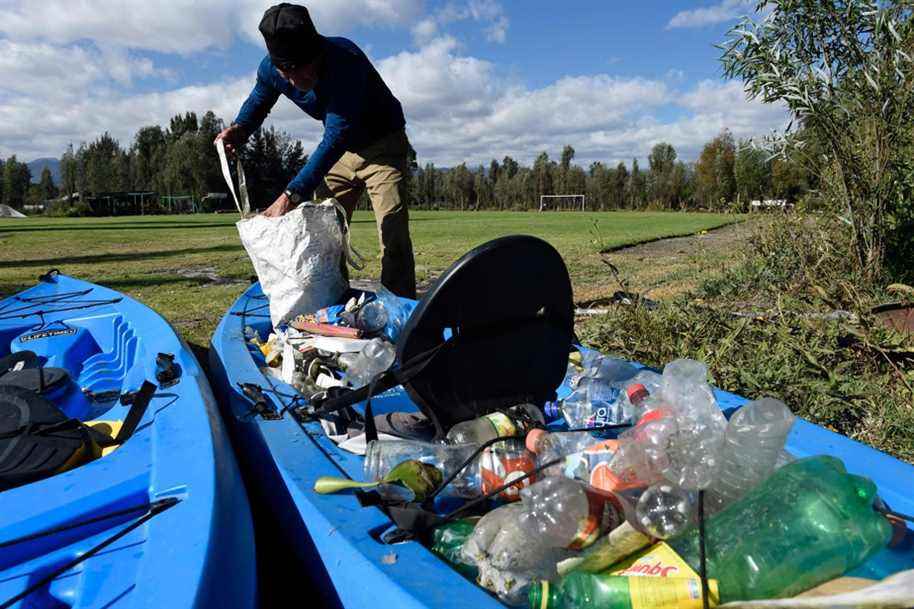(Mexico City) In the silence, the cold air and the chiaroscuros of dawn, Omar rows on the canals of Xochimilco, the last trace of pre-Hispanic Mexico that the retiree tries to protect with his bare hands against the pollution of mass leisure .
Posted at 8:00 a.m.
As his single-seater kayak passes by, herons and pelicans take flight in the morning mist. To the south, the Popocatepetl volcano culminates at more than 5000 meters between Mexico City and Puebla.
Omar Menchaca, 66, seems to be rowing very far from the network of highways that serves and surrounds Mexico City and its 9 million inhabitants.
“The ring road is only 600 meters away,” smiles the sporty retiree, who parked his car in the pier parking lot, after leaving his house in Coyoacan, a district of Mexico.
Regularly, Omar puts down his oars to pick up with his bare hands rubbish, residues, bottles, packaging packages, which float in the middle of the aquatic flowers.
“I came here to train for my competitions,” says the former athletics champion. “Over time, unfortunately, I started noticing that these channels were covered in garbage.”
His canoe continues its way between the banks of the “chinampas”, floating market gardens that have existed for centuries.
Xochimilco, its canals and “chinampas” represent the last survival of pre-Hispanic Mexico-Tenochtitlan, which fascinated the Spaniards with its network of islands and islets on Lake Texcoco.
Omar knows the story by heart. He shares it with tourists during the tours he organizes to several canoes. He loves to see children imitate him in collecting waste.
Xochimilco is also famous for its “trajineras”, huge festive gondolas. On board, every weekend, couples, families and groups of friends sail, drink and eat to the sound of the unmissable mariachi orchestras.
“Xochimilco is visited by approximately 6,000 people on weekends. Unfortunately, these people don’t take care of the place,” laments Omar.
“If we do nothing…”
He also observes that chinampas have been covered over by football pitches, increasing the pressure of mass recreation.
The pensioner gets annoyed when he comes across boats equipped with a small engine. “The canals are not very deep, barely 50 centimeters deep. A boat with a motor that carries up to 40 people causes noise. It pollutes wetlands with oil and gasoline”.
At midday, Omar returns to the pier through a vast canal with a breathtaking view of Ajusco, a peak at 3900 m within the limits of the federal capital.
His canoe is overflowing with debris and rubbish. On the way, Omar greets a man who pulls shovels of mud from the waters of the canal, a natural fertilizer, he explains.
“People at the pier should be picking up trash, not Don Omar,” said the man, a Xochimilco regular named Noe Coquis Salcedo.
On dry land, Omar dumps the trash in a landfill, next to the pier parking lot.
Omar believes that he is just bringing “his grain of sand” to safeguarding an environment listed as a UNESCO heritage site. The local authorities claim to also take care of the Xochimilco canals and the “chinampas”. “Maintenance is constant,” says the town hall, speaking of the 160 kilometers of canals to be maintained.
“The canals are paths”, philosopher Omar, seated at the table of a restaurant on the edge of the pier, the time of an “enchilada” (corn pancake filled with chicken and covered with sauce) and a “clara” (lager beer) after hours of physical exercise. “That’s why when I see this garbage, I try to collect it so that whoever passes after can enjoy a clean path”.
Under the January sun, young people dive into the canal. “If we do nothing for our planet, there will come a time when…”.
Omar remains silent for a moment, his hands outstretched. “Where we will have few things left to enjoy”.
